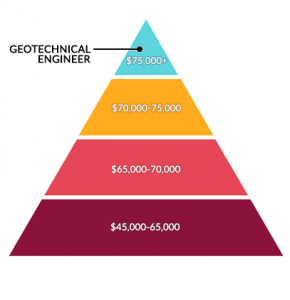The Only Guide to Geotheta
The Only Guide to Geotheta
Blog Article
Indicators on Geotheta You Should Know
Table of ContentsWhat Does Geotheta Do?Geotheta - TruthsOur Geotheta IdeasGetting My Geotheta To WorkThe Greatest Guide To Geotheta

They conduct website investigations, gather samples, execute lab examinations, and evaluate data to assess the viability of the ground for construction tasks - Geo Tech Engineering. Based upon their findings, geotechnical designers offer referrals for structure layout, slope stability, maintaining frameworks, and mitigation of geotechnical threats. They team up with other professionals, such as designers, architectural designers, and building and construction teams, to guarantee that geotechnical considerations are incorporated right into the general project design and implementation
By assessing the actions and homes of dirt and rock, they can determine potential geotechnical dangers such as landslides, soil negotiation, or incline instability. Their experience aids stop failures or crashes that might endanger lives and residential or commercial property. Right here are some in-depth obligations and duties of a geotechnical designer: Website Examination: Geotechnical designers conduct website investigations to gather data on subsurface problems.
They analyze the data to recognize the residential or commercial properties and actions of the soil and rock, including their stamina, permeability, compaction qualities, and groundwater conditions. Geotechnical Analysis and Layout: Geotechnical designers assess the data accumulated during site investigations to assess the security and viability of the site for building projects. They perform geotechnical calculations and modeling to examine aspects such as birthing ability, negotiation, incline stability, side planet stress, and groundwater flow.
The Ultimate Guide To Geotheta
Structure Layout: Geotechnical designers play a crucial role in creating structures that can safely support the intended framework. They analyze the soil problems and tons requirements to identify the suitable structure kind, such as superficial structures (e.g., footings), deep structures (e.g (https://geotheta.weebly.com/)., piles), or specialized techniques like soil improvement. They consider elements such as settlement restrictions, bearing capability, and soil-structure interaction to establish optimum foundation styles
They assess building and construction strategies, display website activities, and conduct area inspections to validate that the style suggestions are followed. If unforeseen geotechnical concerns arise, they analyze the circumstance and provide referrals for removal or modifications to the design. Threat Analysis and Mitigation: Geotechnical designers evaluate geotechnical risks and threats linked with the project website, such as landslides, liquefaction, or soil disintegration.

Collaboration and Communication: Geotechnical engineers function carefully with various other professionals entailed in a job, such as architects, architectural engineers, and building and construction groups. Effective interaction and partnership are crucial to incorporate geotechnical considerations into the total task layout and building and construction procedure. Geotechnical designers offer technical experience, response questions, and guarantee that geotechnical requirements are satisfied.
The 10-Second Trick For Geotheta
Right here are some sorts of geotechnical engineers: Foundation Designer: Foundation designers specialize in developing and examining foundations for frameworks. They examine the soil problems, load needs, and website features to establish one of the most appropriate structure type and design, such as superficial structures, browse this site deep structures, or specialized strategies like stack structures.
They evaluate the aspects influencing incline security, such as soil buildings, groundwater problems, and incline geometry, and establish approaches to avoid slope failures and minimize threats. Earthquake Designer: Quake designers focus on examining and creating frameworks to hold up against seismic pressures. They examine the seismic danger of a site, examine dirt liquefaction capacity, and establish seismic layout standards to make certain the security and durability of structures during earthquakes.
They carry out area testing, collect samples, and evaluate the accumulated information to characterize the soil homes, geologic developments, and groundwater conditions at a site. Geotechnical Instrumentation Engineer: Geotechnical instrumentation engineers concentrate on tracking and determining the actions of dirt, rock, and frameworks. They install and keep instrumentation systems that keep track of factors such as dirt settlement, groundwater levels, incline motions, and architectural variations to analyze efficiency and provide very early warnings of possible issues.
The Ultimate Guide To Geotheta
They carry out tests such as triaxial tests, consolidation examinations, straight shear examinations, and leaks in the structure tests to collect data for geotechnical evaluation and design. Geosynthetics Designer: Geosynthetics designers focus on the design and application of geosynthetic products, such as geotextiles, geogrids, and geomembranes. They make use of these materials to boost dirt stability, enhance inclines, give water drainage services, and control erosion.
They tend to be investigative people, which indicates they're intellectual, reflective, and investigative. They are curious, methodical, logical, analytical, and sensible. Some of them are also social, indicating they're kind, generous, cooperative, client, caring, valuable, empathetic, sensible, and friendly - Geotechnical Engineers.
In the workplace setting, geotechnical designers use specialized software devices to execute estimations, produce designs, and examine data. They prepare reports, review task requirements, interact with customers and employee, and coordinate job activities. The workplace setting gives a favorable atmosphere for research, evaluation, and collaboration with various other specialists entailed in the project.
Not known Facts About Geotheta
They regularly check out job sites to carry out site examinations, examine geotechnical conditions, and gather data for evaluation. These brows through involve traveling to different places, in some cases in remote or tough surfaces. Geotechnical designers might do soil sampling, conduct examinations, and monitor building tasks to make certain that the geotechnical elements of the project are being implemented appropriately.
Geotechnical designers also operate in specialized geotechnical laboratories. In these facilities, they perform experiments, perform tests on soil and rock samples, and assess the design buildings of the products. Geotechnical laboratory designers function extensively in these settings, taking care of testing tools, operating instruments, and videotaping data. They work together with other research laboratory staff to ensure accurate and dependable testing results.
Report this page